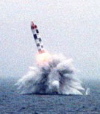The second failed test launch of Russia's experimental Bulava (R-30 SS-NX-30) submarine-launched ballistic missile (SLBM) in as many months has renewed doubts about the viability of the country's strategic nuclear deterrent, and in turn increased fears that Russian policy makers might adopt "hair-trigger" operational procedures to guarantee that their nuclear forces could survive and respond to a first strike. The Bulava is a three-staged missile designed to carry up to six individually targeted nuclear warheads for a range of approximately 8,000-10,000 kilometers. The two back-to-back failures have effectively suspended the test program. Previously, the missile had been scheduled to enter service in 2008, after completing at least ten additional test launches. The missile tested on Oct. 25 automatically self-destructed after veering off course three minutes after launch from the Dmitry Donskoy nuclear submarine in the White Sea. The target had been a testing range in the far-eastern Kamchatka Peninsula. The previous Bulava test launch, from the same submarine on Sept. 7, also failed when the missile fell into the sea one minute after takeoff. Following the first mishap, Defense Minister Sergei Ivanov said the government had become concerned about the viability of the maritime component of Russia's strategic nuclear deterrent. In February 2004, the navy experienced two embarrassing failures during tests of its older SLBMs when, in the presence of President Vladimir Putin, one missile failed to launch and a second exploded shortly after takeoff. The short time between the Bulava launches would suggest a rushed, if now evidently counterproductive, effort to set aside doubts about the missile.
Russian Missile Test Failure Increases Fears of Nuclear ‘Hair-Trigger’

